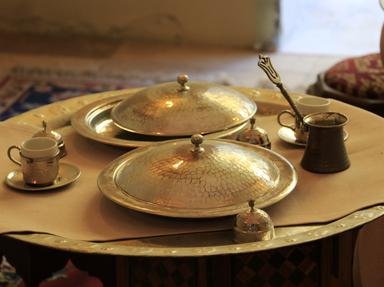Quiz Answer Key and Fun Facts
1. The first guest to arrive for my dinner party was the writer Jonathan Swift. He would have dined on fricassee, or a ragout during the 18th century and may even have partaken in my choice of dessert of the period. A classic French dish simply consisting of cold custard and meringue. It had a name which I found appropriate since he wrote about Laputa in his book "Gulliver's Travels". What is the dessert called?
2. My next guest at the dinner table was a distinguished gentleman who was also from the 18th century, the highly esteemed Prime Minister, William Pitt the Younger. He had travelled all night after introducing a new law in Parliament called the Commutation Act. Which related beverage did I offer him to quench his thirst?
3. "It is a truth universally acknowledged, that a single man in possession of a good fortune, must be in want of"...ahem...a good cook! Which of these foods would Jane Austen NOT have served up to Mr Fitzwilliam Darcy in the late 18th century at his Pemberley stately home?
4. Mr Sake Dean Mahomed spoke very fine English when he emigrated to England from India in 1810. He explained during our dinner conversation about the time he opened Britain's first Indian restaurant, setting the precedence for other curry houses and introducing the British to undeniably spicy Asian cuisine. What was the name of this restaurant?
5. Charles Dickens was an amusing guest at the dinner table and had us in stitches when he read an excerpt from one of his books. "Hallo! A great deal of steam! The pudding was out of the copper. A smell like a washing-day! That was the cloth. A smell like an eating-house and a pastry cook's next door to each other, with a laundress's next door to that! That was the pudding." Which classic British pudding was being described?
6. I cordially invited the genteel Mrs Elizabeth Beeton to my dinner party in celebration of my tercentenary as I needed her assistance in creating ratafias to accompany our after dinner drinks. Ratafia was one of the recipes taken from her 1861 published "Book of Household Management", but what were they?
7. I doubt if Queen Victoria would have eaten this ice cream treat but she may not have been amused when they banned this product from the streets of London. Street vendors sold these all over the place, but the 'elf & safety' police soon put a stop to that, me old mucker! Which ice cream was banned in 1899?
8. My next guest was Winston Churchill. He sustained energy "in his finest hour" by fine dining, drinking wine and smoking cigars. His cook at Chartwell House was an experimental chef, even though war rations put a stop to certain delicacies, she used everything she could get her hands on and used all parts of an animal to cook with. One of the recipes she served was Cervelles Connaught, but what was this awful, I mean offal, dish better known as?
9. The confectioner John Cadbury refused dessert but accepted a warming cup of hot chocolate as we finished dinner. He was a sweet man but was horrified to learn that seventy years after his death in 1889, his company started advertising a brand new product using martian robots on a new-fangled talking box called a television. Which food product was this?
10. All my guests enjoyed their evening and took up my offer of staying the night. Even my final guest, Heston Blumenthal, offered to cook us breakfast in the morning; the same food that he sent to British astronaut Tim Peake on the International Space Station in 2016. Which dish is on our menu ?
Source: Author
Plodd
This quiz was reviewed by FunTrivia editor
WesleyCrusher before going online.
Any errors found in FunTrivia content are routinely corrected through our feedback system.

